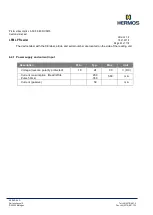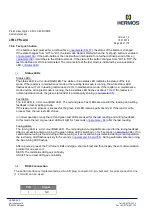
Protocol description ASCII, SECS/HSMS
Customer manual
Version 1.2
LFM LP Reader
15.01.2019
Page 15 of 119
HERMOS AG
Gartenstrasse 19
Tel. +49(9279) 991-0
D-95490 Mistelgau
Fax. +49(9279) 991-100
6. Functional description
General information
LF reading devices are radio frequency identification systems that use radio transmission to read or
write data of LF transponders (134,2 kHz), which operate as tamper -proof electronic tags. The LF
reading devices communicate with common transponders according to ISO 18000 -2 and ISO 11785
that are available on the market.
The data is transmitted via the existing interface with the preset transmission parameters. If several
interfaces are available and connected to the host, the transmission is always carried out on the most
recently used interface. The data is embedded in a defined communication protocol and exchanged
between the reader and host.
Basic functions - operating modes
During normal operation, the LF reading device supports various basic functions:
Heartbeat function, software version query
Reading data
Writing data
Locking data
Setting and reading out parameters
Setting and querying inputs and outputs
The LF devices can be set in 3 other operating modes by s etting the parameters: Polling operation
(optional), sensor-triggered automatic reading and test mode.
6.2.1
Normal operation
During normal operation, the LF reading device is immediately ready for operation after a reset. It does not
perform any automatic actions in this mode (standby). During normal operation, actions are triggered by
protocol commands from the host.
A scanning procedure or reading in the data area is initiated by a command of the host system using the
communication protocol.
In addition to the actions triggered by the host, a corresponding message can be automatically sent to the
host and an automatic reading operation can be started by activating or releasing a sensor.
When the reading operation is successful, the read data is immediately transmitted to the host. If several
antenna ports are occupied simultaneously, the reading operations are processed sequentially.
Writing actions (data saved to a transponder) are generally only possible via commands from the host.
6.2.2
Polling mode
LF reading devices can be set into a continuous reading state, which is referred to as polling mode.
The device then performs reading operations at regular intervals and outputs the corresponding data of
the read LF transponder.
The reading device also continues carrying out protocol messages in polling mode. This may, however,
result in delays in the poll rhythm.
The polling functionality is optional customer-specific available!
6.2.3
Sensor-triggered operation
Device versions with IO port offer the function of a sensor-triggered automatic reading operation. The
reading device automatically performs a reading operation when the input is triggered. The type of action
















































